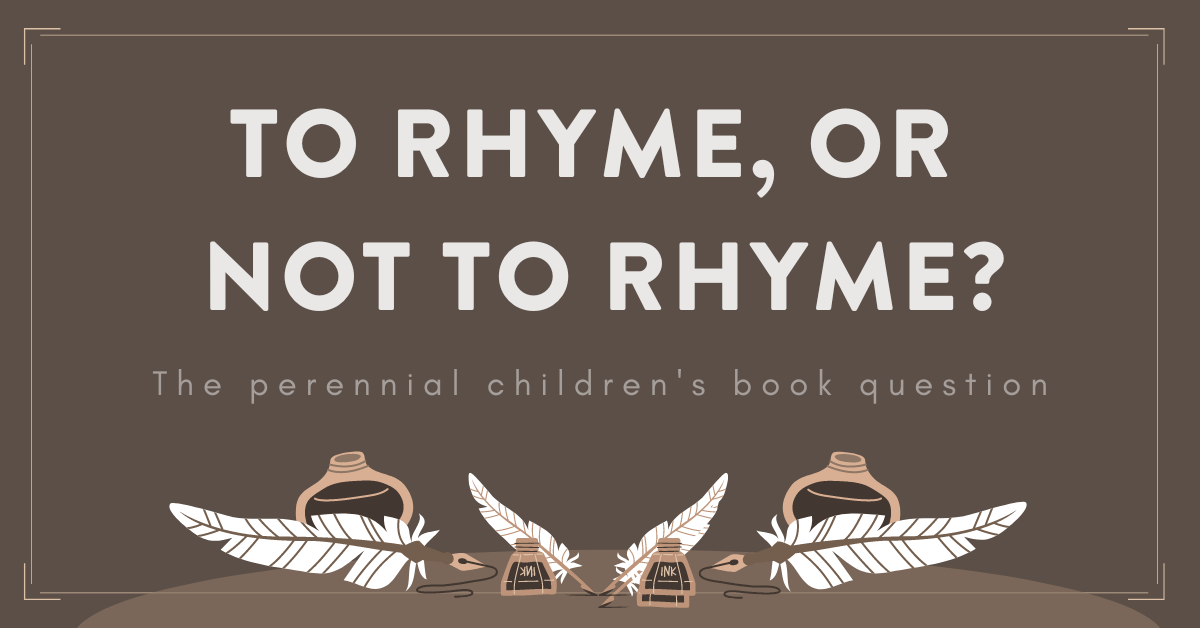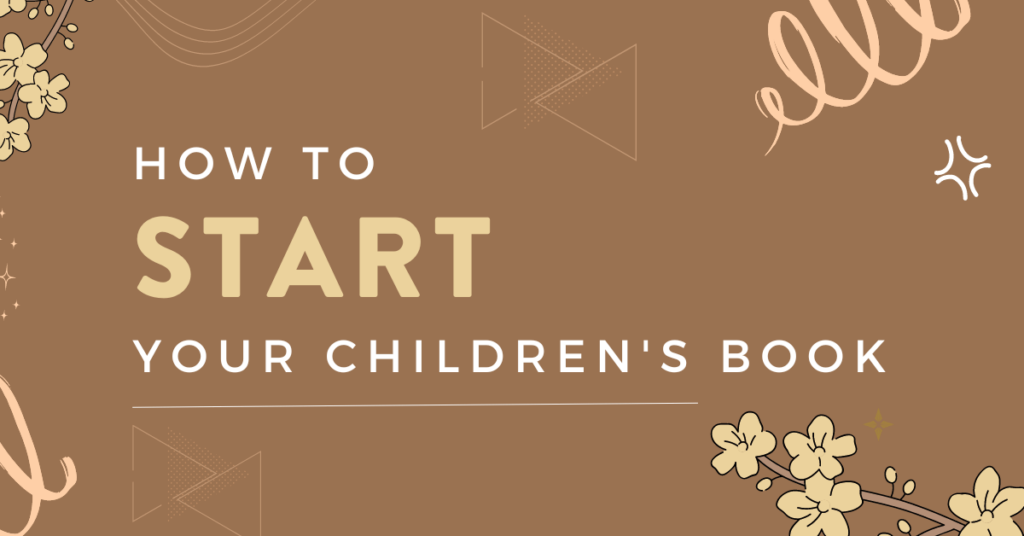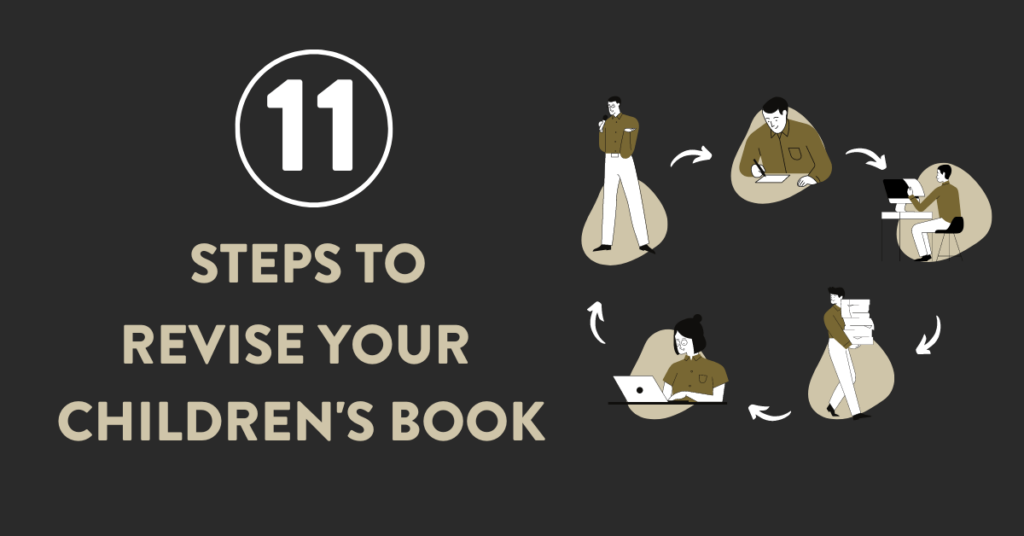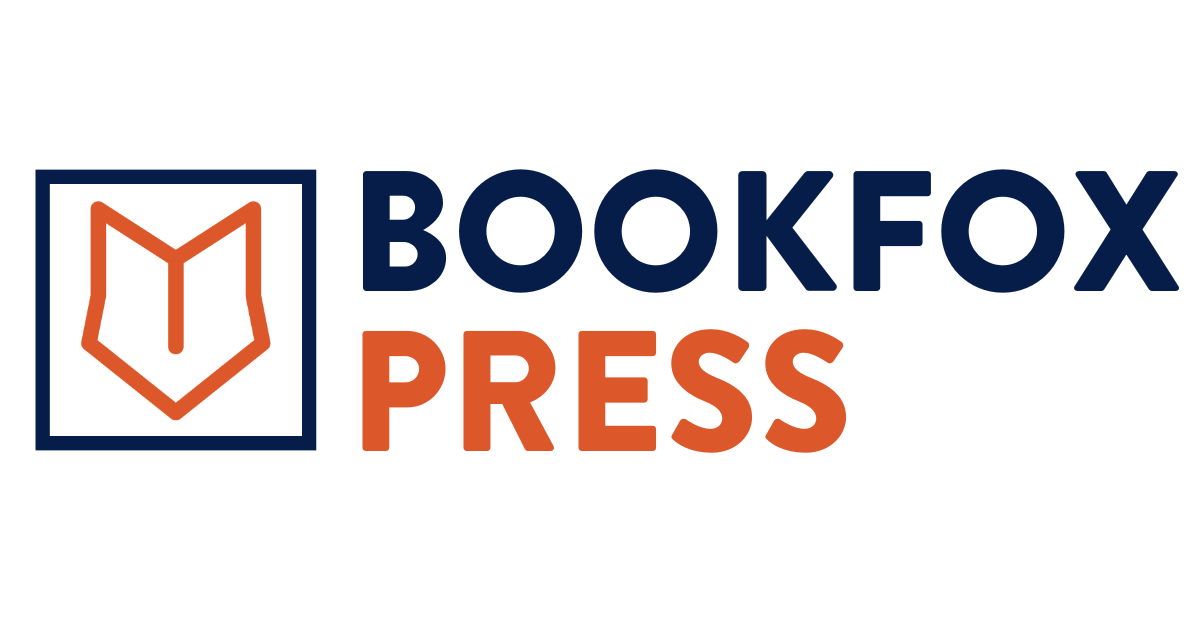
Ah, the age-old debate for budding children’s book authors: to rhyme or not to rhyme.
Most beginning writers think children’s books have to rhyme. This is probably because when they were young, they were brought up reading books like Dr. Seuss and were conditioned to believe.
But the surprising thing is that most children’s books DON’T rhyme. That’s right! It’s kind of a myth that children’s books rhyme. In fact, publishers tend to prefer prose books for a number of reasons, so don’t feel like you have to rhyme.
That said — you can write a rhyming book if you want to. However, after you finish reading this post, I think I might make you doubt whether you should rhyme.
Crafting a rhyming children’s book is about as difficult as catching a whale, and not every author is cut out to be a poet.
Here are the questions you need to ask yourself if you want to write a rhyming book. If you can answer all these questions affirmatively, then I give you my blessing.
If not, save yourself a thousand heartaches and just write the book in prose. And if you need to know more about how to write a children’s book in general, look at my free benchmark article on how to write a children’s book in 12 steps.
1. Are you a poet?
I was going to edit for a client and she asked me whether I was fine with editing poetry books. I said I was, and about 25% of the books I edited rhymed, but I asked whether she was good at poetry.
She told me that she’d published about 50 poems in literary magazines! Well, that changed my tune right away. I told her I was overjoyed to read her children’s book written as poetry, because she had all the basics down.
But most writers don’t have the basics down.
It’s very difficult to learn the whole craft of poetry if you are starting from scratch. It’s a little like deciding you’re going to paint a watercolor painting. Unless you have some background as an artist, it will takes years to even become mediocre.
2. Do you think poetry is about rhyme?
If you do, you probably shouldn’t write poetry. I mean sure, rhyme is one aspect of poetry, but it’s only one out of 7 or 8 techniques that you need to be paying attention to.
I’m not trying to be snobby or elitist or anything, I promise! But as an editor, I see a lot of books where the author has successfully rhymed, but …
Unfortunately, all the other aspects of poetry, like stanza length, meter, cadence, alliteration, enjambment, and a dozen other things, were completely wonky.
Writing poetry, especially for children, isn’t just about stringing together words that rhyme. It’s an intricate dance involving meter, cadence, rhyme, stanza length, and more. Every poetic line, every word, even every syllable can make a difference.
You also have to focus on:
- Meter: This refers to the rhythmic structure of lines. It involves the pattern of stressed and unstressed syllables. You might’ve heard terms like iambic pentameter (used by Shakespeare) – this is where meter comes into play.
- Cadence: Think of this as the musicality or flow of the poem. It’s how the words sound together and how they roll off the tongue.
- Rhyme: Beyond the obvious end rhymes (e.g., cat/hat), there’s slant rhyme, internal rhyme, and other varieties to consider.
- Stanza Length: This is about the number of lines in a stanza, and it affects the poem’s pacing and structure.
3. Can you count syllables?
I’m deadly serious — you cannot write a book of children’s poetry if you can’t count syllables.
And yes, you have to count the syllables in every line, and yes, each line has to be within a syllable or two of each other.
Sometimes I get books where one line is 6 syllables long, and the next one is 15 long, and I feel like it’s verbal Wild Wild West where anything goes!
Poetry has rules. If your first line has 10 syllables in it, then every line should have between 9 – 11 syllables.
4. Can you write standardized stanzas?
What is a stanza? It’s like a paragraph, for poetry. It’s a grouping of lines that hold together.
Most poetry books I edit veer wildly between shorter and longer stanzas.
A three line stanza butts up against a seven line stanza, followed by a two-line stanza and then a three line stanza. It’s complete mayhem, without any order or sense.
Pick a size, pick any size! Stanzas come in all shapes and sizes. The most common one is the quatrain – that’s a fancy word for four lines. But there are also:
- couplets (2 lines)
- tercets (3 lines)
- and even those hefty sestets (6 lines).
Consistency is key, folks! Once you’ve chosen your stanza style and rhyme scheme, stick with it. It’s like when you find that perfect beat and just can’t stop grooving. Your readers will appreciate the flow.
One Exception: when you’re writing your final stanza, or the stanza just before your climax, sometimes you can have a stanza that’s half the length (2 instead of 4). This is a way to tell the reader:
- You’re coming to the end of the story
- You’re coming up on the climax
That’s basically the one time you can break up the stanza length and dance to the beat of a different drummer.
5. Can you stick to the same rhyme scheme?
You have to use the exact same rhyme scheme throughout your whole book.
There’s no sense in writing ABAB, and then switching to ABCB, and then switching to AABB.
If the second and fourth line rhyme, then the second and fourth line need to rhyme in EVERY SINGLE STANZA.
And if the first and third line DON’T rhyme, then never rhyme them! It’s all about consistency.
It’s not just about making words rhyme, but ensuring that the chosen scheme complements your story without feeling forced or contrived.
6. Can you make every stanza rhyme?
It’s inevitable. Authors send me a rhyming manuscript and they’re doing fantastic — I mean, every stanza is rhyming. And then I hit the snag: a stanza without any rhyme at all.
It’s difficult to overstate just how jarring this is. And if a parent is reading your book out loud, it’s going to fall so flat they’ll throw the book across the room.
Every single stanza needs to rhyme. You don’t get any free passes. There are no exceptions. If you fall out of the pattern, you’re not longer writing poetry. Poetry IS form. Poetry is a kind of standardization.
The pleasure of poetry is being able to expect the same flow of words stanza in and stanza out — every single line must conform to the form.
7. Can you use enjambment?
I’d say that one out of every four poetry manuscripts I receive, the author hasn’t formatted the poetry correctly.
This is what a poetry manuscript looks like without enjambment, with apologies to Dr. Seuss’s “Horton Hatches the Egg”:
I meant what I said. And I said what I meant. An elephant’s faithful one hundred per cent!
And this is what it looks like with enjambment:
I meant what I said
And I said what I meant….
An elephant’s faithful
One hundred per cent!
Enjambment just means that you hit the return key and start a new line whenever you have the rhyming word. It’s really, really, really important, because otherwise you’re just writing prose that occasionally rhymes. It’s what tells the reader that they’re reading poetry.
8. Can You Avoid the Pitfall of Forced Rhymes?
There is nothing worse than reading a rhyming book that prioritized rhyme over story clarity.
Forced rhymes can disrupt the flow, making the narrative feel unnatural. It’s essential to strike a balance, ensuring that the essence of your story isn’t sacrificed for the sake of a rhyme.
What’s more, it’s exceedingly difficult for me as an editor to try to find a word that:
- rhymes (obviously)
- makes sense in the context of the story
- is an appropriate diction level for children
- matches the voice of the writer
9. Can you limit your language?
It’s difficult enough to be a poet, but it’s doubly difficult when you can’t use most of the words in the dictionary.
I often edit for clients who are using polysyllabic words or super esoteric words that kids won’t understand, and they’re doing that because it has the right meter or because it rhymes. But I have to tell them that the diction level is simply too high for kids.
Kids are smart cookies, but some words just haven’t made it into their vocabulary party yet. Go too fancy, and you might lose them.
10. Are You Ready for the Challenges of Revising Poetry?
Let’s say you were able to do everything I asked for in the first nine questions. Congrats!
You’ve passed the first gauntlet.
Unfortunately, you have an even bigger challenge ahead: Revising poetic verses is 10,000 times more difficult than revising prose. Changing even a single word throws off the entire meter, which screws up the rhyme, and suddenly you’re rewriting three stanzas and you’ve checked the thesaurus nineteen thousand times.
Basically, when I give editorial feedbakc to a poetry book writer, I apologize beforehand, because I realize that every piece of big picture advice is going to cost them hours or days in revision work. On the other hand, a prose write could whip out a revision in an hour or two, and then head off to the bar for a cocktail.
If you’re not prepared for this meticulous level of revision, save yourself the heartbreak and just stick with prose.
What’s your score?
How many questions were you able to answer in the affirmative?
Honestly, you’re a trooper just for getting this far in the article. Kudos to you.
I’m sorry if I discouraged you with the piece above. You really shouldn’t feel discouraged, just know that it’s super hard. If you have your heart set on writing poetry, then go ahead and make it poetry. Nothing worth doing is easy anyway.
And to be honest, as curmudgeonly as I’ve been in this article, I’m really just trying to help children’s book authors. And at Bookfox Press, we publish both poetry books and prose children’s books.
FAQs
Q: How do I choose the right meter for my story?
A: Think about the pace and mood you want to set. A lively, bouncing story might benefit from a quicker meter like anapestic tetrameter (think Dr. Seuss), while a more gentle tale might use iambic pentameter. Experiment and see what fits best!
Q: Are there specific rhyme schemes best suited for children?
A: While there’s no one-size-fits-all, AABB and ABAB are popular because they’re straightforward and memorable. However, the best rhyme scheme often depends on your story and personal style.
Q: What if I run out of rhyming words?
A: Rhyme dictionaries and online tools can be a lifesaver! But also, don’t be afraid to tweak your story a bit to find the best rhymes. Sometimes, the challenge of rhyming can lead to even more creative storytelling!
Q: Are repetitive refrains a good idea?
A: Yes, they can be! Repetition helps children predict and remember the text, making reading interactive and boosting their confidence.
Q: How do I avoid making the rhymes feel forced?
A: The key is to prioritize the story over the rhyme. If a rhyme isn’t coming naturally, it might be a sign to rework that part of the story. Also, reading aloud helps! If it sounds off to your ear, it might feel forced.
Q: Is it necessary for the entire book to rhyme?
A: Yes. Yes. Yes.
Q: I’m not a poet. Can I still write a rhyming children’s book?
A: You will have to become a poet in order to write a rhyming children’s book. Everyone has to start somewhere. Read widely, practice, get feedback, and refine your skills.
Q: How long should my poetic children’s book be?
A: This largely depends on the age group. For very young readers (0-3), shorter is often better. For older kids, you have more flexibility, but brevity remains a strength in children’s literature.
Just remember that poetry lengths should be half prose lengths. For instance, they say that 1000 words is the upper length for a picture book, but if you’re writing poetry, it’s more like 300 – 400 words is the upper limit.
Q: How can I ensure my poetry isn’t too complex for kids?
A: Read it out loud, preferably to kids! If they’re engaged, you’re on track. If they’re lost, simplify. Also, consider the age-appropriateness of themes and vocabulary.
Q: How do I handle feedback that my poetry is too “old-fashioned”?
A: Poetry styles evolve. If feedback suggests it’s too archaic, try modernizing your language or themes. However, some classic structures and styles remain beloved, so trust your instincts too.




One thought on “Should My Children’s Book Rhyme?”
Thank you so much you have really helped me understand the core information I was looking for. I am a primary school teacher in Scotland. I often write stories and poems as part of my teaching. I would love to refine my skills. Are their any poetry course you could recommend? I have wrote and redrafted a story which I intend to be a rhyming picture book one day. I would love for someone to help me refine this. Who would you recommend?